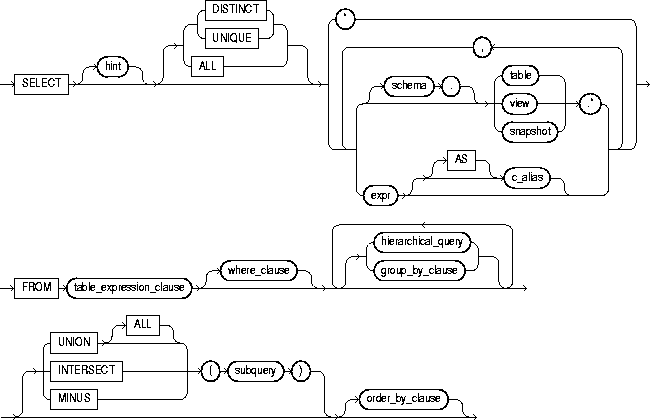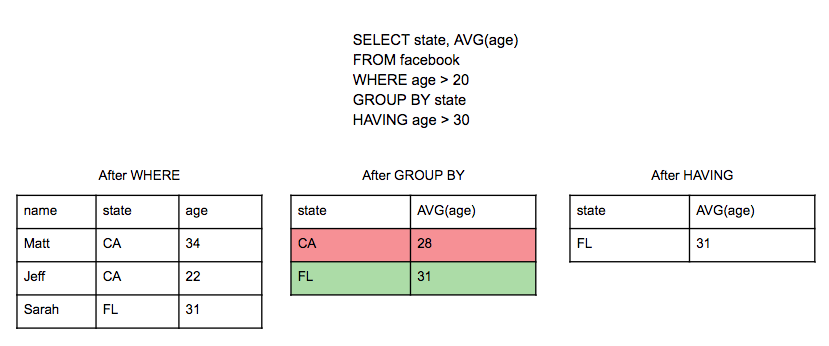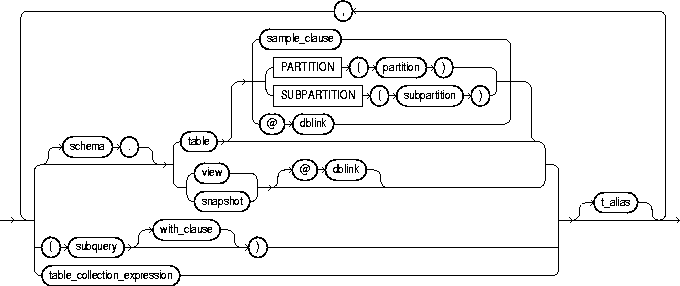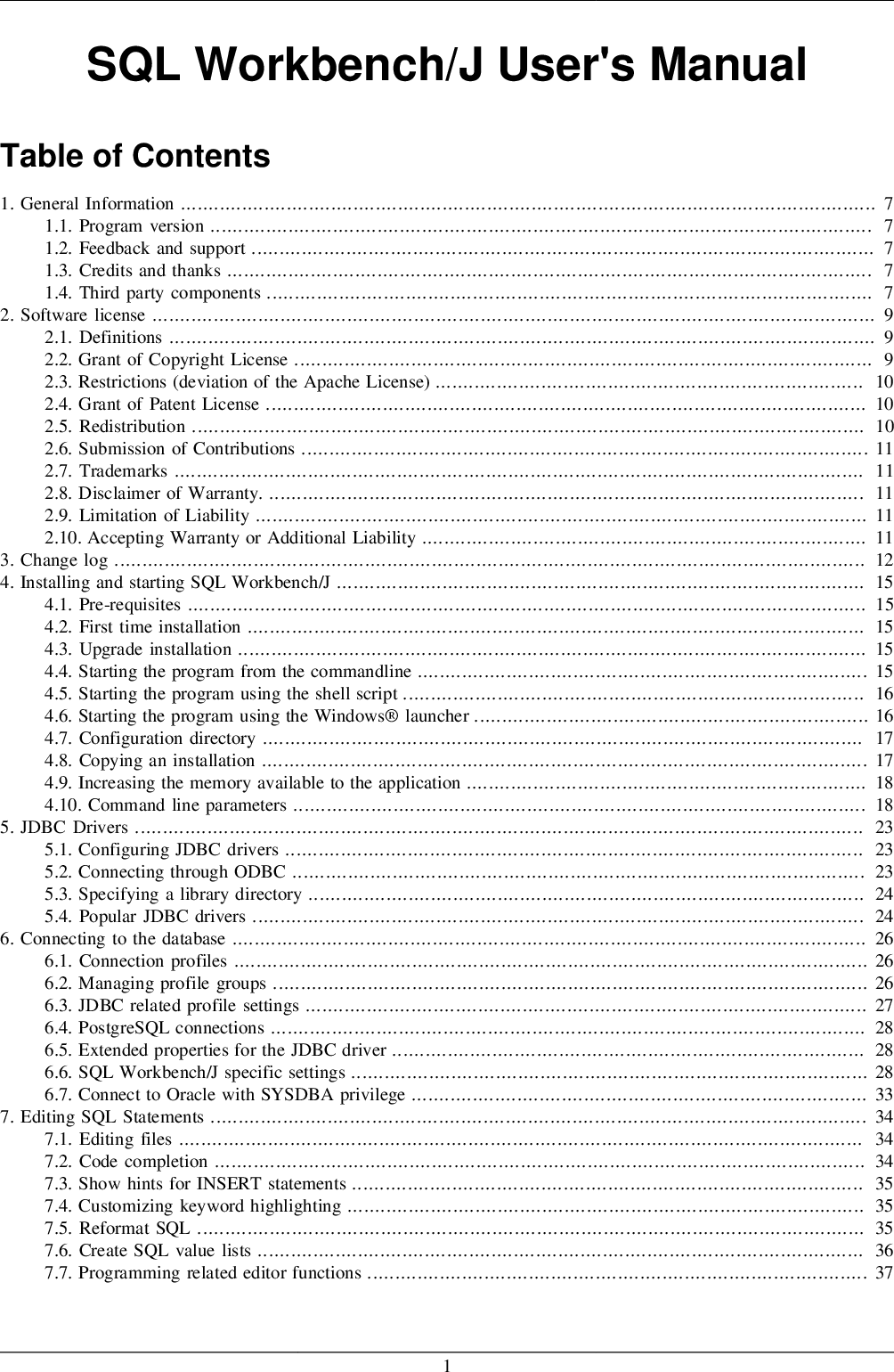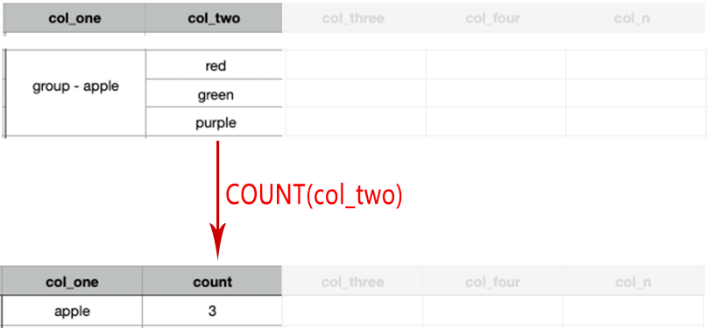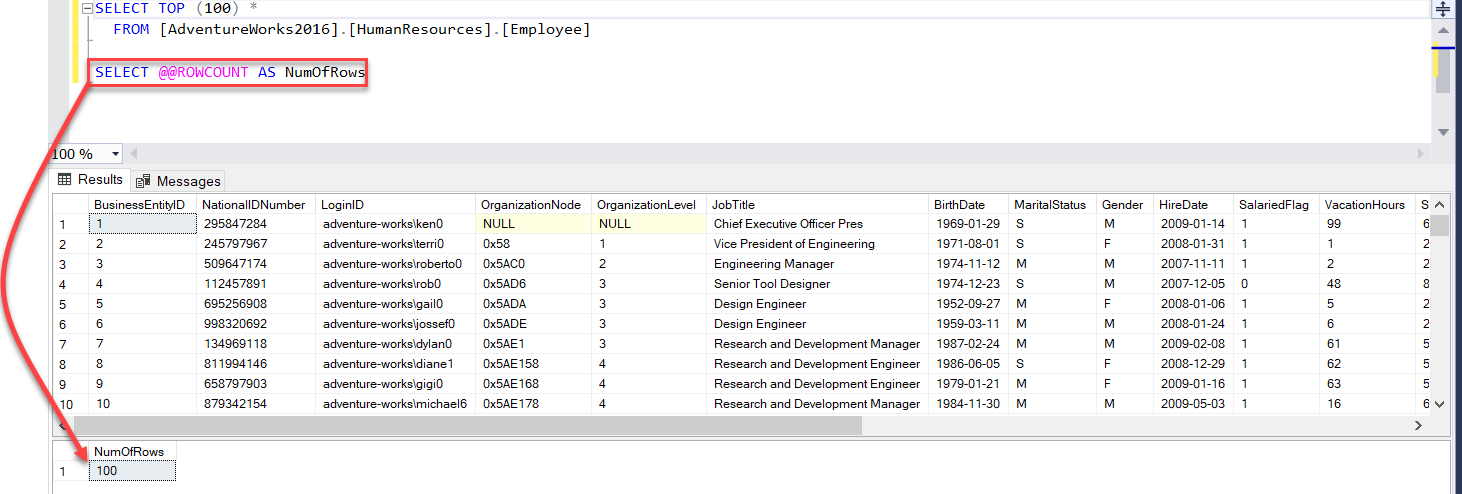Expression_n Expressions that are not encapsulated within an aggregate function and must be included in the GROUP BY Clause at the end of the SQL statement. Aggregate_function This is an aggregate function such as the SUM, COUNT, MIN, MAX, or AVG functions. Aggregate_expression This is the column or expression that the aggregate_function will be used on.
There must be at least one table listed in the FROM clause. These are conditions that must be met for the records to be selected. If more than one expression is provided, the values should be comma separated. DESC sorts the result set in descending order by expression.
Though both are used to exclude rows from the result set, you should use the WHERE clause to filter rows before grouping and use the HAVING clause to filter rows after grouping. In other words, WHERE can be used to filter on table columns while HAVING can be used to filter on aggregate functions like count, sum, avg, min, and max. The GROUP BY clause groups together rows in a table with non-distinct values for the expression in the GROUP BY clause. For multiple rows in the source table with non-distinct values for expression, theGROUP BY clause produces a single combined row.
GROUP BY is commonly used when aggregate functions are present in the SELECT list, or to eliminate redundancy in the output. If a query contains table columns only inside aggregate functions, the GROUP BY clause can be omitted, and aggregation by an empty set of keys is assumed. Once the rows are divided into groups, the aggregate functions are applied in order to return just one value per group. It is better to identify each summary row by including the GROUP BY clause in the query resulst. All columns other than those listed in the GROUP BY clause must have an aggregate function applied to them. As a result, all the returned query rows distributed into groups are characterized by the same combinations of these column values.
It is essential that NULL values are considered equal in this case, i.e. when grouping by the column including NULL values all rows will be combined in one group. ROLLUP is an extension of the GROUP BY clause that creates a group for each of the column expressions. Additionally, it "rolls up" those results in subtotals followed by a grand total. Under the hood, the ROLLUP function moves from right to left decreasing the number of column expressions that it creates groups and aggregations on.
Since the column order affects the ROLLUP output, it can also affect the number of rows returned in the result set. A query can contain both a WHERE clause and a HAVING clause. The HAVING clause is then applied to the rows in the result set. Only the groups that meet the HAVING conditions appear in the query output.
You can apply a HAVING clause only to columns that also appear in the GROUP BY clause or in an aggregate function. Using Group By with Inner Join SQL Inner Join permits us to use Group by clause along with aggregate functions to group the result set by one or more columns. Group by works conventionally with Inner Join on the final result returned after joining two or more tables. We can often use this clause in collaboration with aggregate functions like SUM, AVG, MIN, MAX, and COUNT to produce summary reports from the database. It's important to remember that the attribute in this clause must appear in the SELECT clause, not under an aggregate function.
As a result, the GROUP BY clause is always used in conjunction with the SELECT clause. The query for the GROUP BY clause is grouped query, and it returns a single row for each grouped object. This article explains the complete overview of the GROUP BY and ORDER BY clause. They are mainly used for organizing data obtained by SQL queries. The difference between these clauses is one of the most common places to get stuck when learning SQL. The main difference between them is that the GROUP BY clause is applicable when we want to use aggregate functions to more than one set of rows.
The ORDER BY clause is applicable when we want to get the data obtained by a query in the sorting order. Before making the comparison, we will first know these SQL clauses. All the expressions in the SELECT, HAVING, and ORDER BY clauses must be calculated based on key expressions or on aggregate functions over non-key expressions . In other words, each column selected from the table must be used either in a key expression or inside an aggregate function, but not both.
In this case, the server is free to choose any value from each group, so unless they are the same, the values chosen are nondeterministic, which is probably not what you want. Furthermore, the selection of values from each group cannot be influenced by adding an ORDER BY clause. Result set sorting occurs after values have been chosen, and ORDER BY does not affect which value within each group the server chooses. Table 9-50 shows aggregate functions typically used in statistical analysis.
In all cases, null is returned if the computation is meaningless, for example when N is zero. Aggregates applied to all the qualifying rows in a table are called scalar aggregates. An aggregate function in the select list with no group by clause applies to the whole table; it is one example of a scalar aggregate. The GROUP BY clause groups identical output values in the named columns. Every value expression in the output column that includes a table column must be named in it unless it is an argument to aggregate functions.
GROUP BY is used to apply aggregate functions to groups of rows defined by having identical values in specified columns. The SQL GROUP BY Statement The GROUP BY statement groups rows that have the same values into summary rows, like "find the number of customers in each country". The GROUP BY statement is often used with aggregate functions ( COUNT() , MAX() , MIN() , SUM() , AVG() ) to group the result-set by one or more columns. The Group by clause is often used to arrange identical duplicate data into groups with a select statement to group the result-set by one or more columns.
This clause works with the select specific list of items, and we can use HAVING, and ORDER BY clauses. Group by clause always works with an aggregate function like MAX, MIN, SUM, AVG, COUNT. The GROUP BY statement groups rows that have the same values into summary rows, like "find the number of customers in each country". The GROUP BY clause is often used in SQL statements which retrieve numerical data. It is commonly used with SQL functions like COUNT, SUM, AVG, MAX and MIN and is used mainly to aggregate data.
Data aggregation allows values from multiple rows to be grouped together to form a single row. The first table shows the marks scored by two students in a number of different subjects. The GROUP BY clause defines groups of output rows to which aggregate functions can be applied. It is not permissible to include column names in a SELECT clause that are not referenced in the GROUP BY clause. The only column names that can be displayed, along with aggregate functions, must be listed in the GROUP BY clause.
Since ENAME is not included in the GROUP BYclause, an error message results. The above query includes the GROUP BY DeptId clause, so you can include only DeptId in the SELECT clause. You need to use aggregate functions to include other columns in the SELECT clause, so COUNT is included because we want to count the number of employees in the same DeptId. The SUM() function returns the total value of all non-null values in a specified column. Since this is a mathematical process, it cannot be used on string values such as the CHAR, VARCHAR, and NVARCHAR data types.
When used with a GROUP BY clause, the SUM() function will return the total for each category in the specified table. The HAVING clause filters group rows created by the GROUP BY clause. The HAVING clause is applied to each group of the grouped table, much as a WHERE clause is applied to a select list. If there is no GROUP BY clause, the HAVING clause is applied to the entire result as a single group.
The SELECT clause cannot refer directly to any column that does not have a GROUP BY clause. The GROUP BY clause is often used with aggregate functions such as AVG(), COUNT(), MAX(), MIN() and SUM(). In this case, the aggregate function returns the summary information per group. For example, given groups of products in several categories, the AVG() function returns the average price of products in each category. The ORDER BY clause specifies a column or expression as the sort criterion for the result set.
If an ORDER BY clause is not present, the order of the results of a query is not defined. Column aliases from a FROM clause or SELECT list are allowed. If a query contains aliases in the SELECT clause, those aliases override names in the corresponding FROM clause. Otherwise, each column referenced in the SELECT list outside an aggregate function must be a grouping column and be referenced in this clause. All rows output from the query that have all grouping column values equal, constitute a group.
If you don't use GROUP BY, either all or none of the output columns in the SELECT clause must use aggregate functions. If all of them use aggregate functions, all rows satisfying the WHERE clause or all rows produced by the FROM clause are treated as a single group for deriving the aggregates. You must use the aggregate functions such as COUNT(), MAX(), MIN(), SUM(), AVG(), etc., in the SELECT query. The result of the GROUP BY clause returns a single row for each value of the GROUP BY column. The GROUP BY clause is a SQL command that is used to group rows that have the same values.
Optionally it is used in conjunction with aggregate functions to produce summary reports from the database. If the WITH TOTALS modifier is specified, another row will be calculated. This row will have key columns containing default values , and columns of aggregate functions with the values calculated across all the rows (the "total" values).
Clause is used without any aggregate function in the SELECT clause, the query will simply return one row from each group. Beside the DISTINCT keyword, this opportunity may be used in eliminating the row duplicates from the result set. Aggregate functions are functions that take a set of rows as input and return a single value. In SQL we have five aggregate functions which are also called multirow functions as follows. Optionally it is used in conjunction with aggregate functions to produce the resulting group of rows from the database. The GROUP BY clause is used in a SELECT statement to group rows into a set of summary rows by values of columns or expressions.
Which Sql Query Must Have Must Have A Group By Clause This statement will return an error because you cannot use aggregate functions in a WHERE clause. WHERE is used with GROUP BY when you want to filter rows before grouping them. The SQL GROUP BY clause allows us to group individual data based on defined criteria. You can group individual data by one or more table columns. In order to do the grouping properly, you often need to apply aggregate functions to the column within the SQL SELECT statement.
The HAVING clause is used instead of WHERE with aggregate functions. While the GROUP BY Clause groups rows that have the same values into summary rows. The having clause is used with the where clause in order to find rows with certain conditions. The having clause is always used after the group By clause.
Having Clause is basically like the aggregate function with the GROUP BY clause. Another extension, or sub-clause, of the GROUP BY clause is the CUBE. The CUBE generates multiple grouping sets on your specified columns and aggregates them.
In short, it creates unique groups for all possible combinations of the columns you specify. For example, if you use GROUP BY CUBE on of your table, SQL returns groups for all unique values , , and . The SQL COUNT() function returns the number of rows in a table satisfying the criteria specified in the WHERE clause. The above syntax is the general SQL 2003 ANSI standard syntax. An ORDER BY clause in SQL specifies that a SQL SELECT statement returns a result set with the rows being sorted by the values of one or more columns.
The sort criteria do not have to be included in the result set. The SELECT statement used in the GROUP BY clause can only be used contain column names, aggregate functions, constants and expressions. If none of the rows was returned by the query , the source data for any aggregate function to be calculated is missing.
In such case, the COUNT function returns zero, while other functions return NULL. Non-commutative aggregate functions are sensitive to the order in which the rows are processed in the surrounding SELECT clause. To specify the order in which input rows are processed, you can add an ORDER BY clause within the function argument list.
HAVING Clause is used as a conditional statement with GROUP BY Clause in SQL. WHERE Clause cannot be combined with aggregate results so Having clause is used which returns rows where aggregate function results matched with given conditions only. It should be noted that except for count, these functions return a null value when no rows are selected. In particular, sum of no rows returns null, not zero as one might expect, and array_agg returns null rather than an empty array when there are no input rows. The coalesce function can be used to substitute zero or an empty array for null when necessary. A subquery with a recursive table reference cannot invoke aggregate functions.
The INTERSECT operator returns rows that are found in the result sets of both the left and right input queries. Unlike EXCEPT, the positioning of the input queries does not matter. Aggregates applied to a group of rows in a specified column or expression are called vector aggregates. For either aggregate type, the results of the aggregate operations are shown as new columns that the having clause can refer to. However, you can use the GROUP BY clause with CUBE, GROUPING SETS, and ROLLUP to return summary values for each group.
Here, you can add the aggregate functions before the column names, and also a HAVING clause at the end of the statement to mention a condition. This statement is used to group records having the same values. The GROUP BY statement is often used with the aggregate functions to group the results by one or more columns. Adding a HAVING clause after your GROUP BY clause requires that you include any special conditions in both clauses. If the SELECT statement contains an expression, then it follows suit that the GROUP BY and HAVING clauses must contain matching expressions.






